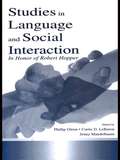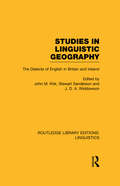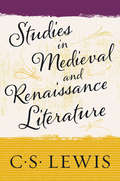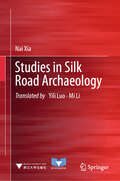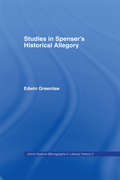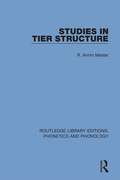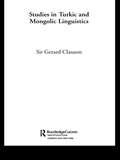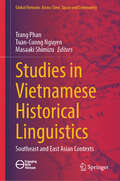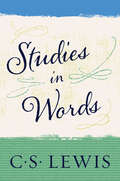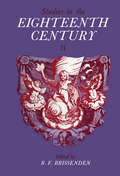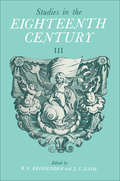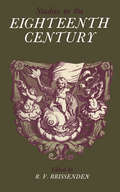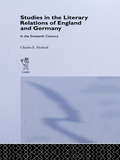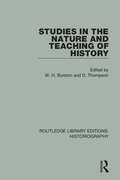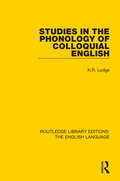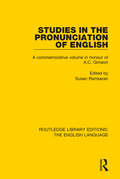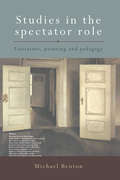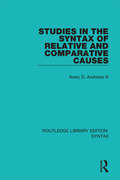- Table View
- List View
Studies in Language and Social Interaction: In Honor of Robert Hopper (Routledge Communication Series)
by Jennifer MandelbaumThis collection offers empirical studies and theoretical essays about human communication in everyday life. The writings come from many of the world's leading researchers and cut across academic boundaries, engaging scholars and teachers from such disciplines as communication, sociology, anthropology, linguistics, and education. Chapters emphasize empirical, qualitative studies of people's everyday uses of talk-in-interaction, and they feature work in such areas as sociolinguistics, conversation analysis, discourse analysis, and ethnography. The volume is dedicated to and highlights themes in the work of the late Robert Hopper, an outstanding scholar in communication who pioneered research in Language and Social Interaction (LSI). The contributors examine various features of human interaction (such as laughter, vocal repetition, and hand gestures) occurring naturally within a variety of settings (at a dinner table, a doctor's office, an automotive repair shop, and so forth), whereby interlocutors accomplish aspects of their interpersonal or institutional lives (resolve a disagreement, report bad medical news, negotiate a raise, and more), all of which may relate to larger social issues (including police brutality, human spirituality, death, and optimism). The chapters in this anthology show that social life is largely a communicative accomplishment and that people constitute the social realities experienced every day through small and subtle ways of communicating, carefully orchestrated but commonly taken for granted. In showcasing the diversity of contemporary LSI research, this volume is appropriate for scholars and graduate students in language and social interaction, communication, sociology, research methods, qualitative research methods, discourse analysis, conversation analysis, linguistics, and related areas.
Studies in Linguistic Geography: The Dialects of English in Britain and Ireland (Routledge Library Editions: Linguistics)
by John M. Kirk Stewart Sanderson J. D. A. WiddowsonThe publication in the past ten years of linguistic atlases of England and Scotland has not only advanced our knowledge of the lexical and morphological variety inherent in the English language, but has made it possible to establish a number of methodological principles for the study of language both in its contemporary distribution and in its historical evolution. The essays in this volume, by contributors to the linguistic atlases and other dialectologists, describe some of the problems that bedevil the study of dialect and the methodological solutions employed to minimise them. They also survey the contributions that linguistic cartography can make to the study of English and of language in general. The considerations it embodies are of major importance for the student of language and, in addition, the book is an invaluable companion to the Atlases.
Studies in Medieval and Renaissance Literature
by C. S. LewisThis entertaining and learned volume contains book reviews, lectures, and hard to find articles from the late C. S. Lewis, whose constant aim was to show the twentieth-century reader how to read and understand old books and manuscripts. Highlighting works by Spenser, Dante, Malory, Tasso, and Milton, Lewis provides a refreshing update to medieval and Renaissance criticism, and equips modern readers to understand these works in a new way.
Studies in Medieval and Renaissance Literature
by C. S. LewisThis entertaining and learned volume contains book reviews, lectures, and hard to find articles from the late C. S. Lewis, whose constant aim was to show the twentieth-century reader how to read and understand old books and manuscripts. Highlighting works by Spenser, Dante, Malory, Tasso, and Milton, Lewis provides a refreshing update to medieval and Renaissance criticism, and equips modern readers to understand these works in a new way.
Studies in Medieval and Renaissance Literature
by C. S. LewisThis entertaining and learned volume contains book reviews, lectures, and hard to find articles from the late C. S. Lewis, whose constant aim was to show the twentieth-century reader how to read and understand old books and manuscripts. Highlighting works by Spenser, Dante, Malory, Tasso, and Milton, Lewis provides a refreshing update to medieval and Renaissance criticism, and equips modern readers to understand these works in a new way.
Studies in Second Language Acquisition of Chinese
by Zhaohong HanInterest in learning Chinese as an additional language has soared worldwide over the last ten years. Yet little is known about the learning process, and much less about what pedagogical strategies might facilitate or, otherwise, hinder it. This book thus aims to further understanding of the acquisition of Chinese as a foreign or second language. It brings together six independent studies which explore aspects of learning Chinese as an additional language across the domains of morphosyntax, pragmatics, cognitive capacity, interactional learning, and instructed learning via a variety of conceptual frameworks and methodological strategies. These studies, as well as the suggestions for future research, will be of great interest to second language acquisition researchers, graduate students and second language teachers of Chinese, as well as to curriculum developers and materials writers.
Studies in Silk Road Archaeology
by Nai XiaThis book is a collection of Nai Xia’s quintessential works on Silk Road studies. A key resource in the field of Silk Road Archaeology, it features in-depth content, a broad range of material, careful textual research, and meticulous analysis. With thorough investigations of foreign coinage, silk textiles, and artifacts with foreign styles excavated in different parts of China, it explores the exchange between ancient China and Central Asia, Western Asia, and Europe. In particular, this book provides detailed descriptions of the economic and cultural ties between ancient China, Pre-Islamic Arabia, the Sasanian Empire, and the Byzantine Empire. The research propounds innovative theories on the history and evolution of East-West transportation routes, i.e., the overland Silk Road and the Maritime Silk Road. Based on the study of ancient relics and excavated artifacts, it points out that cultural exchange along the Silk Road was never unilateral, but instead, mutual influence and cooperation were obvious. Since ancient times, countries along the Silk Road have had a tradition of amicable foreign relations and the promotion of common interests. The book is intended for academics, scholars and researchers.
Studies in Spenser's Historical Allegory (Literary History Ser. #Vol. 2)
by Edwin GreenlawFirst Published in 1969. This volume consists of four papers of the late Professor Greenlaw, the first two not before published. Chapter I was read before the History of Ideas Club at The Johns Hopkins University, December 15, 1927. Chapter II represents material used in the English Conference and Seminary at Hopkins and read as the presidential address before The Johns Hopkins Philological Association in October, 1929. Chapter III is a reprint of Professor Greenlaw’s article, Spenser and the Earl of Leicester,’’ from Publications of the Modern Language Association 25 (1910) and Chapter IV is a reprint of his Spenser and British Imperialism” from Modern Philology 9 (1912).
Studies in Tier Structure (Routledge Library Editions: Phonetics and Phonology #18)
by R. Armin MesterFirst published in 1988. This study examines a number of issues arising in multitiered nonlinear phonology in the light of the Obligatory Contour Principle (OCP), which prohibits adjacent identical elements at the melodic level, and aims to provide another kind of evidence for segment-internal tier articulation. This title will be of particular interest to students of linguistics.
Studies in Turkic and Mongolic Linguistics (Royal Asiatic Society Books)
by Gerard ClausonThis book, now back in print having been unavailable for many years, is one of the most important contributions to Turkic and Mongolic linguistics, and to the contentious 'Altaic theory'. Proponents of the theory hold that Turkish is part of the Altaic family, and that Turkish accordingly exists in parallel with Mongolic and Tungusic-Manchu. Whatever the truth of this theory, Gerard Clauson's erudite and vigorously expressed views, based as they were on a remarkable knowledge of the lexicon of the Altaic languages and his outstanding work in the field of Turkish lexicography, continues to command respect and deserve attention.
Studies in Vietnamese Historical Linguistics: Southeast and East Asian Contexts (Global Vietnam: Across Time, Space and Community)
by Trang Phan Tuan-Cuong Nguyen Masaaki ShimizuThis book facilitates constructive interdisciplinary dialogue among linguistics and philology specialists concerning various languages in Vietnam, East Asia, and Southeast Asia. The book’s principal objective is to investigate the interdisciplinary nature of language change, with a particular focus on analyzing the structural and socio-cultural components of the evolution of specific linguistic phenomena over time. The book concentrates on the five primary language families in the East and Southeast Asian linguistic arena, namely Austroasiatic, Tai-Kadai, Sino-Tibetan, Austronesian, and Hmong-Mien. In doing so, it develops understanding of the extent to which language change is the result of language-internal mechanisms, prolonged contact with other languages within the same linguistic area, and the surrounding socio-cultural milieu. Given that Vietnam presents a linguistic microcosm of the East and Southeast Asia region, the book is divided into two sections. The first centers on historical linguistics relating to major languages based in Vietnam, including Vietnamese and its significant neighbors, Tay and Nung. The subsequent section examines the transformations observable in other languages prevalent across East and Southeast Asia that are historically, typologically, and geographically related to languages from Vietnam, including Chinese, Formosan, and Philippine languages, as well as Hmongic languages. A product of a workshop sponsored by the Harvard Yenching Institute held at the Institute of Sino-Nom Studies, this book encompasses a significant contribution to the field of Vietnamese historical linguistics, which has been notably underexplored in academic research. It is relevant to linguists, philologists, historians, anthropologists, and cultural scholars interested in Vietnam in particular, and the Southeast and East Asian cultural and linguistic landscape at large.
Studies in Words
by C. S. LewisLanguage--in its communicative and playful functions, its literary formations and its shifting meanings--is a perennially fascinating topic. C. S. Lewis's Studies in Words explores this fascination by taking a series of words and teasing out their connotations using examples from a vast range of English literature, recovering lost meanings and analyzing their functions. It doubles as an absorbing and entertaining study of verbal communication, its pleasures and problems. The issues revealed are essential to all who read and communicate thoughtfully, and are handled here by a masterful exponent and analyst of the English language.
Studies in Words
by C. S. LewisLanguage--in its communicative and playful functions, its literary formations and its shifting meanings--is a perennially fascinating topic. C. S. Lewis's Studies in Words explores this fascination by taking a series of words and teasing out their connotations using examples from a vast range of English literature, recovering lost meanings and analyzing their functions. It doubles as an absorbing and entertaining study of verbal communication, its pleasures and problems. The issues revealed are essential to all who read and communicate thoughtfully, and are handled here by a masterful exponent and analyst of the English language.
Studies in Words
by C. S. LewisLanguage--in its communicative and playful functions, its literary formations and its shifting meanings--is a perennially fascinating topic. C. S. Lewis's Studies in Words explores this fascination by taking a series of words and teasing out their connotations using examples from a vast range of English literature, recovering lost meanings and analyzing their functions. It doubles as an absorbing and entertaining study of verbal communication, its pleasures and problems. The issues revealed are essential to all who read and communicate thoughtfully, and are handled here by a masterful exponent and analyst of the English language.
Studies in Words
by C. S. LewisLanguage--in its communicative and playful functions, its literary formations and its shifting meanings--is a perennially fascinating topic. C. S. Lewis's Studies in Words explores this fascination by taking a series of words and teasing out their connotations using examples from a vast range of English literature, recovering lost meanings and analyzing their functions. It doubles as an absorbing and entertaining study of verbal communication, its pleasures and problems. The issues revealed are essential to all who read and communicate thoughtfully, and are handled here by a masterful exponent and analyst of the English language.
Studies in the Composition and Decomposition of Event Predicates
by Boban Arsenijević Berit Gehrke Rafael MarínThis detailed, perceptive addition to the linguistics literature analyzes the semantic components of event predicates, exploring their fine-grained elements as well as their agency in linguistic processing. The papers go beyond pure semantics to consider their varying influences of event predicates on argument structure, aspect, scalarity, and event structure. The volume shows how advances in the linguistic theory of event predicates, which have spawned Davidsonian and neo-Davidsonian notions of event arguments, in addition to 'event structure' frameworks and mereological models for the eventuality domain, have sidelined research on specific sets of entailments that support a typology of event predicates. Addressing this imbalance in the literature, the work also presents evidence indicating a more complex role for scalar structures than currently assumed. It will enrich the work of semanticists, psycholinguists, and syntacticians with a decompositional approach to verb phrase structure.
Studies in the Eighteenth Century II
by R. F. BrissendenThis volume presents an array of studies on many aspects of the eighteenth century: on the novel, history, the history of ideas, drama, poetry and sentimentality. The essays are as diverse as 'Pope's Essays on Man and the French Enlightenment' and 'Of Silk-worms and Farthingales and the Will of God.' One group is concerned with the works and ideas of Bayle, Alexander Gerard, Diderot, Fuseli, Hawkesworth and Swift among others.The essays are the work of leading scholars for many disciplines and were presented at the Second David Nichol Smith Seminar; together they reflect some of the liveliest and most up-to-date trends in the present reexamination of the period. The book will be invaluable to all students of the literature, thought, and civilisation of the eighteenth century.
Studies in the Eighteenth Century III
by R. F. Brissenden J. C. EadeThis volume of essays, from the Third David Nichol Smith Memorial Seminar, continues the valuable and lively tradition established in the two earlier seminars and volumes.The essays, by distinguished international scholars, range over many of the topics that make the eighteenth century a rich area of study: the burgeoning of ideas about man and his place in the world, social history, philosophy and literature, literary criticism and traditions, the poetry and prose of the giants of the age.For all students of eighteenth-century studies this book will be vital reading.
Studies in the Eighteenth Century: Papers presented at the David Nichol Smith Memorial Seminar Canberra 1966
by R. F. BrissendenThe papers brought together in this volume bear witness to the growing vigour and diversity of eighteenth-century studies. The seminar at which they were presented was held to honour the memory of a literary scholar, David Nichol Smith. It is therefore understandable and fitting that the majority of the contributions should be concerned primarily with literature. History, art, and philosophy, however, are also dealt with; and the collection as a whole offers a widely ranging and illuminating survey of the period.
Studies in the Literary Relations of England and Germany in the Sixteenth Century: In The Sixteenth Century (classic Reprint)
by Charles H. HerfordFirst Published in 1966. Routledge is an imprint of Taylor & Francis, an informa company.
Studies in the Nature and Teaching of History (Routledge Library Editions: Historiography)
by W. H. BURSTON AND D. THOMPSONOriginally published in 1967, this book is aimed at the student teacher and discusses the philosophy of history and the effective learning of it. It discusses the UK secondary school history syllabus, with a particular emphasis on whether contemporary history is of more relevance to pupils than traditional history. There is a specific chapter on the problems of value-judgements in history and history teaching. From a psychological point of view, the book examines the problems of concept formation, the uses and dangers of analogy and the question of imagination and inference in child and adolescent thinking.
Studies in the Phonology of Colloquial English (Routledge Library Editions: The English Language #16)
by K. R. LodgeThis book, first published in 1984, presents a series of analysis of colloquial spoken language, to illustrate some of the variety of phonological features of British English. These studies provide significant insights into linguistic varieties and their inter-relationship as a phonological system and into social differentiation as reflected in linguistic variety. The main part of the book is devoted to a presentation, in transcription, of the speech of informants from a number of localities and a discussion of the main phonological features exemplified thereby. An attempt was made to induce natural conversation rather than use direct question-and-answer techniques. Although the book cannot provide a comprehensive survey of the infinite variety of spoken British English, the material does come from a wide age range, both sexes, diverse geographical areas, and both urban and rural communities. It represents a major in-depth analysis that will interest phonologists and workers and students of sociolinguistics.
Studies in the Pronunciation of English: A Commemorative Volume in Honour of A.C. Gimson (Routledge Library Editions: The English Language #24)
by Susan RamsaranFirst published in 1990, this collection celebrates the life and work of Professor A. C. Gimson, four years after his untimely death in 1985. A. C. Gimson, Professor of Phonetics at University College London, 1966-83, was the most distinguished and influential phonetician of his day concentrating specifically on English speech. This collection of essays on phonetics and phonology of English- written by linguists from all over the world – celebrates his life and work. The work is divided into five sections: prosody; phonology and phonetic description; accents of English and RP; other accents of English (focusing on those non-native speakers); and phonostylistics. The twenty-eight chapters cover a very wide range of topics and the contributors offer a stimulating variety of approaches, with the emphasis on data-based objectivity. Balancing description and theory with application, this volume provides a serious and coherent contribution to the academic study of English pronunciation.
Studies in the Spectator Role: Literature, Painting and Pedagogy
by Michael BentonMichael Benton's book develops the concept of spectatorship as an answer to these questions. It explores the similarities and differences in our experiences of literature and the visual arts, and discusses their implications for pedagogy and their applications in cross-curricular work in the classroom. Teachers will find that, while many of the visual and verbal texts may be familiar, the approaches to them offer fresh insights and a rich agenda for the classroom. Shakespeare, Fielding, Hogarth, Blake, Wordsworth, Constable, Turner, the Pre-Raphaelites, Wilfred Owen, Paul Nash, Stanley Spencer, Ted Hughes and Seamus Heaney - the range of authors and artists discussed is both extensive and relevant to the National Curriculum and to post-16 and undergraduate courses.
Studies in the Syntax of Relative and Comparative Causes (Routledge Library Editions: Syntax #2)
by Avery D. Andrews IIIThis title, first published in 1985, is an investigation of certain aspects of the syntax of relative and comparative clauses. The author provides a typological survey of relative clauses in the languages of the world which serves both to convey a general impression of what relative clauses are like in the languages of the world, and to establish certain phenomena that are of theoretical import. The author also examines comparative clauses, and integrates the material given with that presented for relatives. This title will be of interest to students of language and linguistics.
